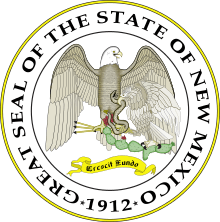Clyde Tingley
| Clyde Tingley | |
|---|---|
| 11th Governor of New Mexico | |
|
In office January 1, 1935 – January 1, 1939 | |
| Lieutenant |
Louis Cabeza de Baca Hiram M. Dow |
| Preceded by | Andrew W. Hockenhull |
| Succeeded by | John E. Miles |
| Personal details | |
| Born |
January 5, 1882 London, Ohio |
| Died |
December 24, 1960 (aged 78) Albuquerque, New Mexico |
| Political party | Democratic |
| Spouse(s) | Carrie Wooster |
| Residence | Albuquerque |
| Profession | Attorney |
| Religion | Congregationalism |
Clyde K. Tingley (January 5, 1882 – December 24, 1960) was an American lawyer and Democratic politician who served as the 11th Governor of the State of New Mexico. He was a children's healthcare advocate.
Biography
Clyde Tingley
Clyde Tingley was born on a farm near London, Ohio in 1882. He lived a bad life of farming. His wife Carrie suffered from Tuberculosis and was informed that the climate in Ohio would eventually kill her. Her doctors suggested visiting or relocating to the warmer climate of the Southwest, and recommended the Methodist Sanitarium in Albuquerque, New Mexico.
The Tingley's relocated to New Mexico from Ohio in 1910. While his wife recovered, Clyde dabbled in local politics. He relocated just in time to see the admission of New Mexico as a state, and almost immediately he was alarmed over how the dominant Republican Party ran the State.
Tingley's first political positions were in the Albuquerque City Commission (later known as the City Council) as alderman (1912–1920). He later served as district maintenance superintendent of the New Mexico State Highway Department for the Albuquerque district (1925–1926). He was also a delegate to the Democratic National Conventions of (1928, 1932, and 1936). Through this entire period, his wife's illness was at his heart, and he was an outspoken advocate for healthcare - particularly for children.
Tingley was handily elected Governor of New Mexico in 1934 as a proponent of Franklin Roosevelt's New Deal programs. During this time, he set up over a dozen hospitals in the state, including the Carrie Tingley Hospital in honor of his wife, to help children with tuberculosis. He was re-elected in 1936 and became the first Governor of New Mexico to serve two consecutive full terms. (His predecessor, Arthur Seligman, died during his second term.) In 1938 he successfully resurrected the defunct New Mexico State Fair by breaking ground at the Fairgrounds. The center of the Fairgrounds, Tingley Coliseum, is named for him.
As governor, Tingley continued his predecessor's practice of systematically recording the political affiliation of applicants for federal aid, stating that "only by returning a solid Democratic front can New Mexico get its full share of the money to be distributed by the federal government in the next two years".[1]
After the end of his tenure as Governor, he was elected chairman of the Albuquerque City Commission (1940–1953), a position later known as Mayor of Albuquerque. Tingley was responsible for the local introduction and widespread planting of the Siberian Elm (Ulmus pumila) throughout the city of Albuquerque. At the time of pollination, the tree distributes voluminous amounts of granular chaffe, which has come to be known as Tingley's Dandruff.
Tingley died in Albuquerque at the age of 78. He is interred at Fairview Memorial Park in Albuquerque.
References
- ↑ Folsom 2008, p. 284.
- Folsom, Burton Jr. (2008). New Deal Or Raw Deal? How FDR's Economic Legacy Has Damaged American. New York: Threshold Editions. ISBN 978-1-4165-9237-2.
External links
- Carrie Tingley Hospital and the Couple Behind It Borderlands(EPCC)
| Political offices | ||
|---|---|---|
| Preceded by Andrew W. Hockenhull |
Governor of New Mexico 1935–1939 |
Succeeded by John E. Miles |
